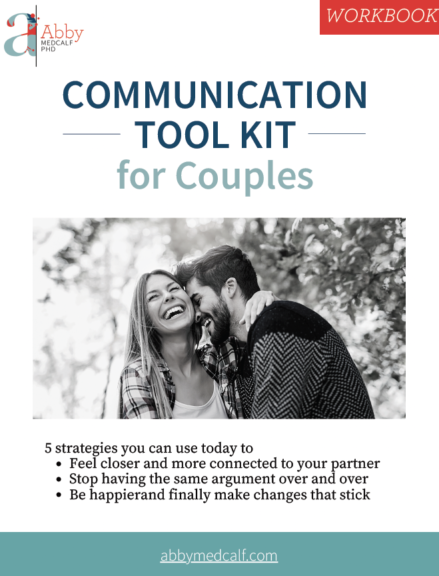
If you’ve ever felt like your partner shuts down when you ask, “How are you feeling?” or you find yourself saying, “I don’t know what I’m feeling; I just feel off,” you might be dealing with something deeper than emotional avoidance. You might be dealing with alexithymia. No, it’s not a disease. Nobody’s broken. But it’s real, and it affects your relationships, your mental health, and your ability to connect with yourself. Because if you don’t know how to identify or express your emotions, it’s going to be hard to have the connections and relationships you want. Today you’ll learn exactly what alexithymia is, the science behind it, and my six-step plan to build the skill of knowing what you’re feeling so you can create more connection, ease, and joy.
9-minute read
What Is Alexithymia?
Alexithymia literally means “no words for emotions.” It’s not a mental illness, but a personality trait marked by difficulty identifying, understanding, and expressing emotions, especially your own. People with alexithymia often focus more on external events than their internal experiences and tend to prefer logic over feelings.
It’s estimated that about 10% of the general population has moderate to severe alexithymia, with higher rates in people with depression, trauma histories, autism spectrum disorders, and substance use disorders. And while alexithymia isn’t a formal mental health diagnosis (meaning it’s not in the DSM), it’s frequently linked to mental health challenges and developmental conditions.
Signs You Might Have Alexithymia (Or Be in a Relationship with Someone Who Does)
Alexithymia isn’t always obvious at first. You might not check every box, but here are the most common signs:
- Struggling to describe feelings beyond basic words like “good” or “bad.”
- Often feeling disconnected from emotions or experiencing them as physical symptoms (tight chest, stomach discomfort).
- Avoiding emotional conversations or feeling overwhelmed by them.
- Tending to intellectualize everything.
- Limited emotional vocabulary — you default to words like “fine,” “stressed,” or “tired.”
- Difficulty expressing emotions verbally or avoiding emotional conversations altogether.
- Seeming emotionally flat or robotic — others might see you as detached, even if you care deeply.
- Low empathy or difficulty picking up on others’ emotional cues.
- Avoiding emotional intimacy and keeping conversations surface-level.
This doesn’t mean you’re cold or uncaring. People with alexithymia can deeply love others; they just might not have the language or tools to express it.
Where Does Alexithymia Come From?
There are two broad types:
Trait (Primary) Alexithymia is present from early life, likely due to neurobiological differences. Brain imaging shows people with trait alexithymia may have reduced activity in areas that process emotions and internal sensations. About 10% of the general population is estimated to have this form.
State (Secondary) Alexithymia develops later, often in response to trauma, chronic stress, or emotional neglect. In high-stress groups like those with PTSD, rates can climb to 40–60%. If you grew up in an environment where emotions weren’t modeled or validated, or if you experienced overwhelming trauma, it makes perfect sense that you’d disconnect from feelings to survive.
The good news: State alexithymia tends to respond well to therapy and interventions, while trait alexithymia may require longer-term skills training but still benefits from neuroplasticity and practice.
What’s Happening in the Brain?
Whether alexithymia is lifelong or developed later, the brain plays a major role. People with alexithymia experience both structural and functional differences in brain regions responsible for processing emotion.
Here’s what we know:
Insular Cortex (Interoception)
The insula helps you sense internal states like hunger, heartbeat, or emotional “butterflies.” With alexithymia, this area shows reduced activity. This means you might feel something in your body but not be able to translate it into an emotion.
Anterior Cingulate Cortex (ACC)
The ACC helps with emotional awareness and empathy. People with alexithymia show lower activation and reduced gray matter volume here, making it harder to process and reflect on emotional experiences.
Amygdala (Emotional Salience)
The amygdala flags emotional experiences as important. When it’s underactive, emotional events might not feel significant, leading to flat or numb reactions.
Connectivity Matters
Alexithymia isn’t just about individual brain regions, it’s about how they communicate. Studies show weakened connections between the amygdala, insula, and prefrontal cortex, making it harder to interpret, regulate, and express emotions.
Why this matters:
Understanding that this is about brain function (not weakness of character) reduces shame and points to hope. Practices like mindfulness, somatic tracking, and therapy can rewire your brain through neuroplasticity. You aren’t stuck this way forever. With state alexithymia, these patterns often reverse with targeted therapy, mindfulness, and nervous system regulation work. Brain scans of people who’ve gone through trauma therapy often show reactivation of these emotional circuits.
How Alexithymia Impacts Relationships
This is where I come in with my bossy Jewish mother energy, because this is the stuff that slowly kills connection. When you can’t recognize or talk about your emotional experience, miscommunication becomes the norm. Partners, friends, and family may feel neglected, dismissed, or emotionally abandoned, even when love is present.
Common patterns I see:
- One person is constantly pulling for emotional connection while the other withdraws.
- Conflict escalates because feelings aren’t named, processed, or resolved.
- Physical intimacy suffers because emotional intimacy is missing.
- Both people feel “alone together.”
Can You “Fix” Alexithymia?
You can’t cure alexithymia, but you can absolutely work with it. Like learning a new language, emotional awareness is a skill that takes time and practice. And thanks to the brain’s neuroplasticity, real change is possible.
Research-backed therapies that help include:
- Emotion-Focused Therapy (EFT) helps people learn to identify, tolerate, and express emotions.
- Mindfulness-based interventions improve interoception and emotional labeling skills
- Cognitive Behavioral Therapy (CBT), especially with a focus on emotional regulation, has been helpful.
- Expressive writing or journaling can build emotional vocabulary and awareness over time.
And while therapy is powerful, there are plenty of things you can do on your own. Let’s get into it.
Action Steps to Start Dealing with Alexithymia
Step One: Mindfulness
You can’t change something you’re not aware of. That’s why mindfulness is the foundation for every one of these steps. Mindfulness simply means noticing your inner and outer experiences without judgment. And for folks with alexithymia, that “noticing” can feel foreign or uncomfortable at first.
So, before you try any of the strategies below, pause and ask:
- What am I sensing in my body right now?
- What thoughts are present?
- Can I be curious instead of critical?
Without that awareness, you’ll either overthink it or shut down, and neither will help you build emotional fluency.
Step Two: Start Labeling Physical Sensations
Most people with alexithymia notice something is “off” physically before they can name an emotion. By tuning into physical sensations, you build the bridge between body and feeling.
How to do it:
- Set a timer 2–3 times a day.
- Pause and scan your body: Is your jaw clenched? Shoulders tight? Stomach fluttery?
- Write it down or name it aloud, even if it feels silly.
Examples:
- At work: Before a meeting, notice if your throat feels tight or your chest heavy. That might be performance anxiety, not just “annoyance.”
- At home: If you feel restless in the evening, check your legs. Is it tension from the day or unprocessed frustration?
- With friends: You feel “off” after a group hang—check your body. That pit in your stomach might be social comparison or emotional fatigue.
Step Three: Expand Your Feeling Vocabulary
You can’t express what you don’t have words for. Most people rely on 5–6 basic emotions (happy, sad, angry, anxious, stressed, tired), but there are dozens more that can help pinpoint what’s actually going on.
How to do it:
- Print out this week’s free Feelings List download or use an app like Mood Meter.
- At the end of the day, choose 3 feeling words that might describe your day.
- Don’t try to “get it right” – just practice guessing.
Examples:
- At work: Instead of “I’m stressed,” maybe you were overstimulated or pressured.
- At home: Instead of “fine,” maybe you felt disappointed or lonely after dinner with your partner.
- With friends: Instead of “awkward,” maybe you were self-conscious or disconnected.
Step Four: Use “Parts” Language
This step is based on Internal Family Systems (IFS) concepts. It’s meant to offer an emotionally safe way to engage with inner experiences when direct identification is too hard or triggering. Research shows that parts language reduces overwhelm and helps people stop judging or suppressing emotional reactions. It’s especially helpful for those with trauma or strong inner critics. So, saying “I feel sad” can feel too exposed. Using “a part of me feels…” creates psychological safety; it lets you explore without feeling overwhelmed or judged.
How to do it:
- What’s happening right now that feels difficult?
- What are the different “parts” of me saying?
- A part of me feels ________
- Another part of me wants to _______
- One part is scared that ______
- What do these parts need from me right now?
- Try: “A part of me feels angry, and another part of me feels guilty about that.”
- Use this when journaling, in therapy, or during self-reflection.
Examples:
- At work: “A part of me is panicking about the presentation. Another part feels excited.”
- At home: “A part of me is hurt my partner didn’t ask how my day was. Another part doesn’t want to seem needy.”
- With friends: “A part of me wants to cancel plans. Another part is afraid of seeming flaky.”
Step Five: Journal Using Emotional Prompts
Writing helps bypass overthinking and gives emotions space to breathe. Prompts remove the pressure of knowing “what to say.”
How to do it:
- Use sentence completions like:
- “I’m worried I’ll never understand my feelings because…”
- “I feel most disconnected when…”
- “If I could say what I’m feeling, it might sound like…”
Examples:
- At work: “I freeze up in meetings because I’m afraid of being judged. I avoid speaking up because…”
- At home: “I get irritable at night because I’m actually feeling…”
- With friends: “I say ‘I’m just tired’ a lot, but what I might really be feeling is…”
Step Six: Focus on Creating Emotional Safety
Alexithymia often shows up because emotions haven’t felt safe. Before you try to feel, speak, or share, make sure you’re emotionally safe. That might mean choosing who you share with, or how.
How to do it:
- Limit emotional conversations with people who dismiss or invalidate you.
- Let yourself process emotions in private before expressing them to others.
- Ask for what you need in low-stakes ways: “I’m trying to name how I feel. I don’t need you to fix it.”
Examples:
- At work: Say to a coworker, “I need a minute to process before I respond to that.”
- At home: Let your partner know, “I’m trying to be more aware of what I’m feeling—it might come out awkward at first.”
- With friends: Try, “I’m working on sharing more. I might stumble through it, but I want to try.”
Wrap Up
If you’re someone who says, “I just don’t do feelings,” it’s time to rethink that. Because relationships, especially the one with yourself, are built on emotional awareness. Alexithymia isn’t your fault. But it’s your responsibility to work with it if you want deeper connection, more joy, and more ease.
Start small. Stay consistent. And know I’m here cheering you on.
For the One Love Collective Community:
Tier One: Inner Circle
- Journaling Prompts
- Trait vs. State Alexithymia: What’s the Difference? Handout
- Emotion Word-of-the-Day 14-Day Challenge
Tier II: Love Accelerator
- Emotion Detective Worksheet: Connecting the Dots Between Triggers, Body, and Feelings
- Feelings Forecast Daily Planner
Tier III: VIP Love Lab
- The Emotion/Need Connection Worksheet
- The Emotional Awareness Action Plan: For When You Don’t Know What You’re Feeling
- Weekly Practice Suggestions
Resources for Why You (or Your Partner) Struggle to Talk About Feelings: Understanding Alexithymia
Get the bundle for this episode for only $8!
Lanius RA, Williamson PC, Densmore M, Boksman K, Neufeld RW, Gati JS, Menon RS. The nature of traumatic memories: a 4-T FMRI functional connectivity analysis. Am J Psychiatry. 2004 Jan;161(1):36-44. doi: 10.1176/appi.ajp.161.1.36. PMID: 14702248.







